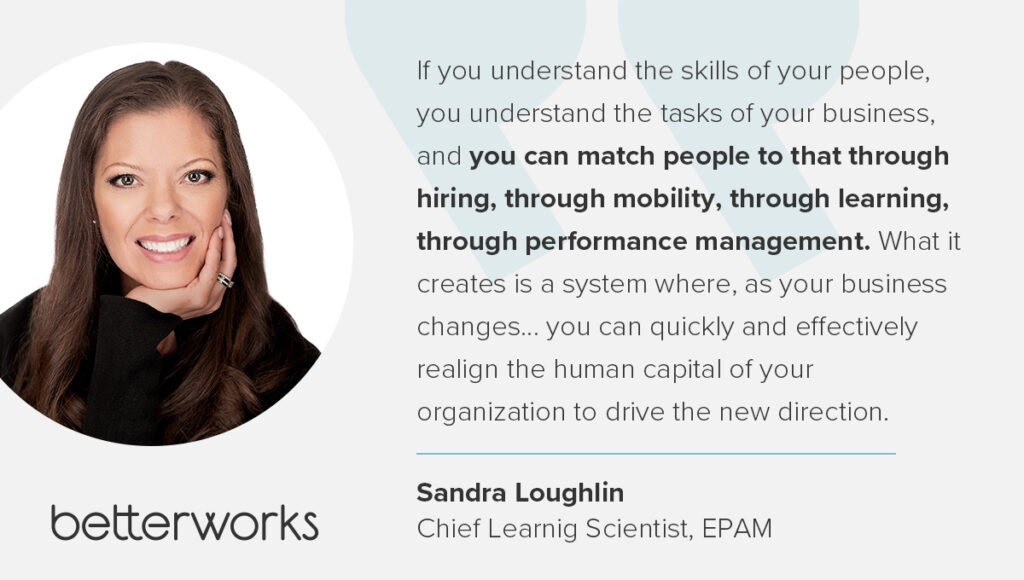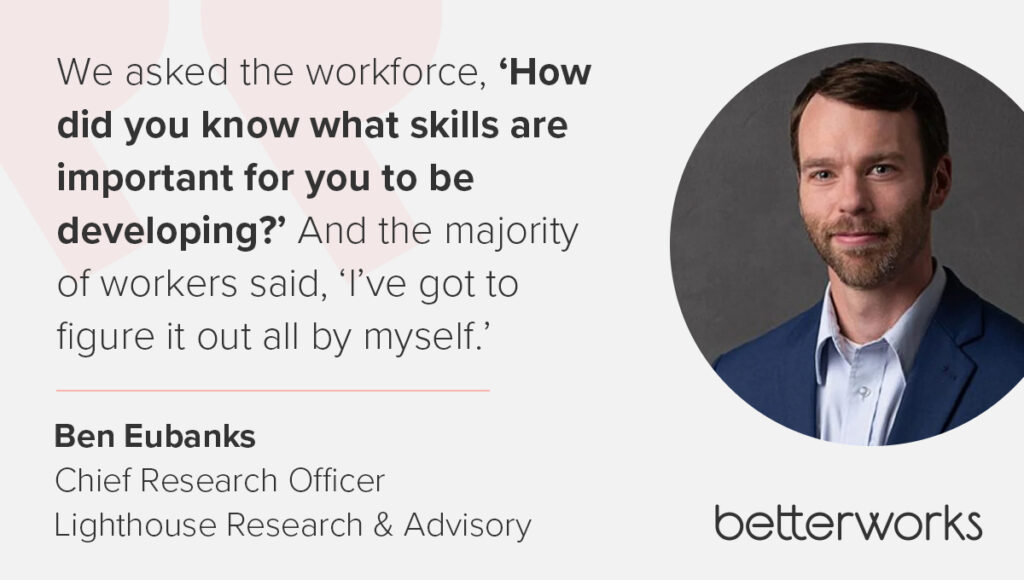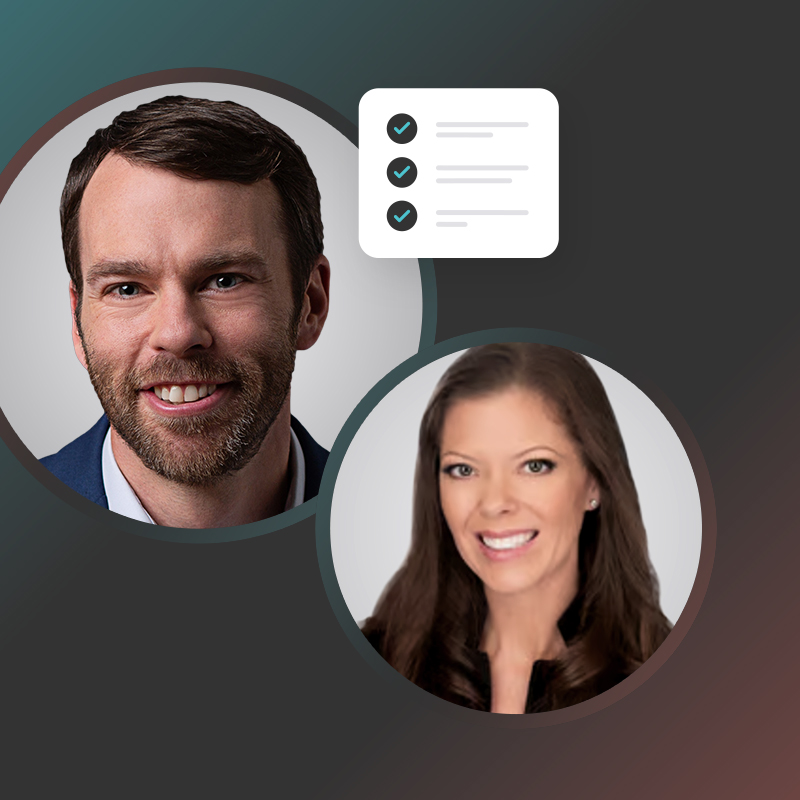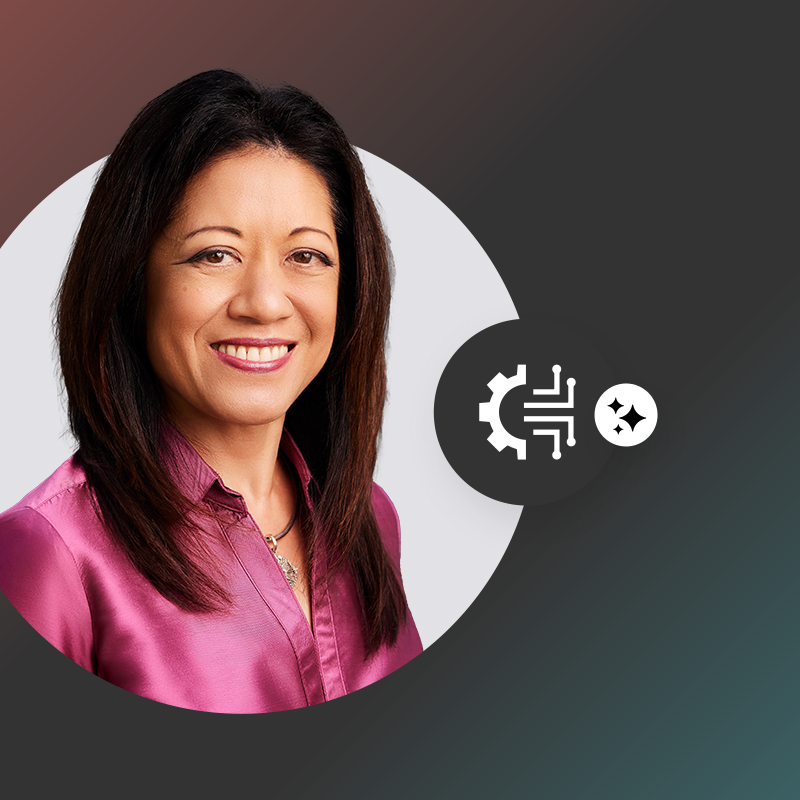AI and automation are accelerating change in the workplace, but organizations are struggling to keep up — not because they lack talent, but because they lack insight into their existing workforce’s skills.
Nearly 7 in 10 organizations use performance evaluations for measuring skills and competencies, but a majority do those assessments once or twice a year, according to the Betterworks 2024 Skills Fitness report. That leaves a significant gap in skills data for most organizations — leaving many vulnerable to disruption.
“Until we understand the skills of our people, we will not be able to effectively and quickly respond to the pressures coming from AI agents and our competitors,” said Ben Eubanks, chief research advisor at Lighthouse Research & Advisory, during a recent webinar, “Skills and AI: What Your Employees Think and What to Do About It.”
Ben was joined on the webinar by Sandra Loughlin, chief learning scientist at EPAM. They discussed ways to rethink how we assess individual skills, validate skills at the workforce level, and communicate about skills across the organization.
Go beyond the resume: A smarter way to assess skills
One of the biggest challenges organizations face is assessing skills accurately. For years, businesses have relied on proxies like years of experience, degrees, or even job titles. But these methods often fall short.
Sandra elaborated on the limitations of this approach: “We make massive and largely incorrect assumptions based on someone’s degree,” she said. “We assume that a job title means that a person has certain skills.” But in many cases, these assumptions are flawed, leading to poor talent decisions.
Ben suggested other methods of assessing skills based on performance. “We’re looking at performance data, what people are actually doing on the job,” he said. Objectively assessing someone’s work can reveal where they’re most skilled. Performance feedback from peers and managers adds another layer validating performance data.
Another way to address this issue by leveraging AI and skill clusters to find skills adjacencies. “Skills tend to come in clusters,” Sandra explained. “If you have skills A, B, and D, you probably have skills C and E.” AI tools can analyze these relationships and infer a candidate or employee’s potential even when it’s not immediately apparent on their resume.

From blind spots to insights: measuring workforce skills at scale
Once you’ve identified the skills of individual employees, the next step is understanding and validating skills across the entire workforce. But many organizations, Ben says, don’t have a clear view of their workforce’s capabilities. He recalls working with a company with 40,000 employees — but leaders only understood the skills present in about 10% of that population.
“This payroll period you pay 36,000 people. You don’t know what they can do beyond their current job title … And that’s a reality for so many companies,” Ben said. “You have to imagine that creates some level of risk for those companies.” Without a clear understanding of workforce skills, companies risk hiring externally for roles that could have been filled internally, overlooking untapped potential.
This is an elusive challenge to solve, Sandra said, but AI demonstrates great potential in understanding and validating workforce skills. “The thing that EPAM, after 30 years of doing this, is still working on is exactly this problem: How do you get high quality data at scale?” Sandra said. “And we have not cracked that code — and I don’t know that we will ever crack it. But if we do, I think it will be through AI-enabled, authentic skill validation.”
Only once you’ve tapped into skills at the workforce level can you achieve what Sandra refers to as the Holy Grail: business agility. “If you understand the skills of your people, you understand the tasks of your business, and you can match people to that through hiring, through mobility, through learning, through performance management,” she said. “What it creates is a system where, as your business changes … you can quickly and effectively realign the human capital of your organization to drive the new direction.”

The skills conversation you’re not having (but should be)
One of the most overlooked aspects of skills strategy is how organizations communicate about skills — if they communicate at all. Many HR leaders responding to a Lighthouse Research & Advisory survey reported that they communicate about skills through managers, Ben said, yet employees often feel left in the dark. “We asked the workforce, ‘How did you know what skills are important for you to be developing?’” Ben said. “And the majority of workers said, “I’ve got to figure it out all by myself.’”
Sandra shared how EPAM prioritizes transparency to address this issue. Employees understand what they’re contributing, how their skills are valued, and how managers use verified skills to make decisions — and that transparency around skills has significantly reduced EPAM’s attrition rates. “They want to have people understand them, and see their value, and then do an amazing job of helping them optimize their skills,” Sandra said.
The workforce is evolving, and the companies that truly understand their people will have the agility to adapt and succeed. Now is the time to take a skills-first approach to your business strategy.
Want to learn more? Catch the replay on demand!
Crack the code on organizational skills



